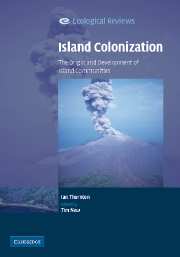Book contents
- Frontmatter
- Contents
- Editorial preface
- Acknowledgements
- PART I Theoretical and experimental studies
- PART II Natural recolonization after devastation
- PART III The recolonization of devastated islands
- PART IV Assembly of biotas on new islands
- PART V Colonization and assembly
- 14 Dispersal
- 15 Stepping stone islands: the case of Sebesi
- 16 Learning from nature's lessons
- References
- Index
15 - Stepping stone islands: the case of Sebesi
Published online by Cambridge University Press: 12 January 2010
- Frontmatter
- Contents
- Editorial preface
- Acknowledgements
- PART I Theoretical and experimental studies
- PART II Natural recolonization after devastation
- PART III The recolonization of devastated islands
- PART IV Assembly of biotas on new islands
- PART V Colonization and assembly
- 14 Dispersal
- 15 Stepping stone islands: the case of Sebesi
- 16 Learning from nature's lessons
- References
- Index
Summary
One way by which the chance of a propagule reaching a given island may be enhanced is by using an intermediate island as a ‘stepping stone’, so in landscape ecology terminology increasing the ‘connectivity’ between different habitat ‘patches’. The theory of stepping stone function was addressed by MacArthur and Wilson (1967), who devoted a chapter of their seminal book to the topic, and by Gilpin (1980). In 1996 I gathered an international team to examine the actual case of Sebesi Island in Sunda Strait, with a view to assessing its importance as a stepping stone in the colonization of Krakatau.
A number of hypotheses, both equilibrial and non-equilibrial, have been proposed to explain variation in island biodiversity (see Whittaker 1998). What is more difficult, however, is to predict which species will be represented in particular island ecosystems. In tackling this problem, Diamond (1975) derived assembly rules for the avifaunas of islands of the Bismarck archipelago based on the identification of exclusion pairs and the incidence functions of species, representing their varied abilities to withstand competition in avifaunas of various sizes. In the build-up of communities, contemporary competition theory implies an effect of priority, early arrivers excluding later competitors, and Ward and Thornton (2000) showed that pioneer communities should be more predictable than later-successional immigrants. The presence of island stepping stones is theoretically likely to influence both the size and make-up of isolated biotas.
- Type
- Chapter
- Information
- Island ColonizationThe Origin and Development of Island Communities, pp. 218 - 238Publisher: Cambridge University PressPrint publication year: 2007



